The Trisha Brown Dance Company performs at the Clark Art Institute and at Jacob’s Pillow.
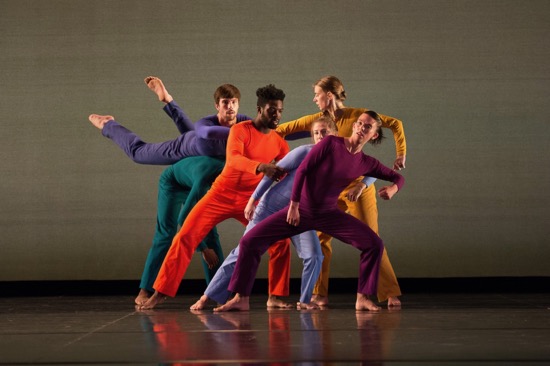
Trisha Brown’s Groove and Countermove. (L to R): Kyle Marshall (head hidden), Patrick McGrath, Oluwadamilare Ayorinde, Kimberly Fulmer, Amanda Kmett’Pendry, and Cecily Campbell. Photo: Christopher Duggan
I’ve never watched a work of Trisha Brown’s without saying to myself, “How did she ever think of that?” I still marvel that an artist so rigorous could be so playful. I’ve envied her rambunctious way with words too. Yesterday, feeling foggy-headed, I went to the refrigerator and screwed the cap off a pretty old tube of harissa (“Le Flambeau du Cap Bon”) that she bestowed on me in, I think, 1990 when I was leaving Angers, France, where I’d been preparing to write a Dance Magazine article about her. I put a bead of it on my tongue. Hot-mouthed and thoroughly awake, I sat back down to write, my memories inflamed by that Tunisian paste. Thanks for that too, Trisha.
Brown died last spring. Her company lives on, guided by executive director Barbara Dufty and artistic directors Carolyn Lucas and Diane Madden (both memorable former Trisha Brown dancers). On Sunday, August 13, people visiting the Clark Institute in Williamstown, Massachusetts had two chances to watch company members perform a version of Trisha Brown: In Plain Site, an event, co-presented by Jacob’s Pillow, that gathered together some of Brown’s task-like works from the 1970s plus an excerpt from the 2002 Geometry of Quiet.
Spectators gathered on the terrace and lawn in front of the building designed by Tadao Ando could view dancers at either very close range or as small, white-clad figures across a vista of water, greensward, and summer visitors. The six performers introduced themselves by standing in a loose, shoulder-to-shoulder line and, in perfect synch, moving their curved arms up over their heads and then down to their sides. Simple? Not really. In this work, Figure Eight, each performer’s two arms move through the pattern differently, with one gradually speeding up while the other slows down.
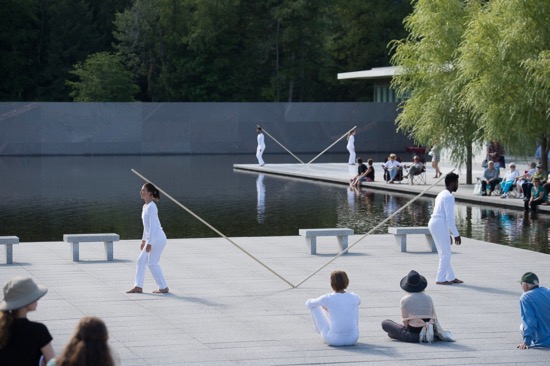
Excerpt fromTrisha Brown’s Sticks at the Clark Art Institute. Foreground: Cecily Campbell and Oluwadamilare Ayorinde, Across the water: Marc Crousillat and Amanada Kmett’Pendry, Photo: Christopher Duggan
A very short excerpt from Sticks is easier to understand (although not easy to do). The members of two couples, situated at some distance from each other, stood back to back on the art institute’s, each with a white pole on the top of his/her head; the poles’ other ends butted against each other on the stone floor. So what we saw was a V uniting each pair of dancers. The task? The two had to descend slowly and carefully to a kneeling position without dropping a pole or making the V look uneven.
We could also watch Jamie Scott and Cecily Campbell build the sequence of gestures titled Accumulation, repeating it from the beginning each time a new move is added. And relish the suspense entailed in waiting to see what that newcomer would be. Scott and Campbell did this quite rapidly, kept in sync despite their distance from each other by a recording of the Grateful Dead’s “Uncle John’s Band” (which figured in another early Brown work).
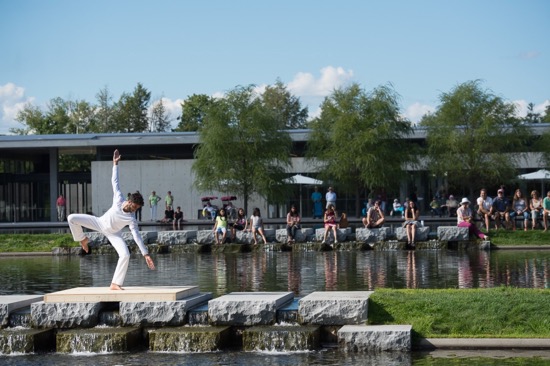
Marc Crousillat performs Trisha Brown’s Locus alone at the Clark Art Institute. Photo: Christopher Duggan
Next, on one of the platforms near me, Mark Crousillat elegantly performed Locus as a solo. Brown designed the movement for this 1975 work as happening within a virtual cube. Numbered points on it correspond to letters drawn from a written statement by Brown (got that?), and the movement consists of touching or indicating the mandated invisible points with various parts of the body, sometimes more than one at a time. What we see is an extraordinarily three-dimensional view of intrepid humanity calmly and fluently exploring the many possibilities involved in turning, bending, sitting, standing, balancing, and reaching.
In contrast to this, the Geometry of Quiet excerpt, with a spare sound score by Salvatore Sciarrino, builds unexpected structures with two dancers interested in linking. You know that it’s going to be surprising when Leah Ives places the sole of her foot on Crousillat’s belly. The ways in which the two kept connecting merge intimacy with a business-like serenity. When Oluwadamilare Ayorinde and Amanda Kmett’Pendry joined them, the task at hand didn’t just involve two couples. At one point Ayorinde collaborated with Ives and Crousillat to turn the initial duet into a trio as exactly like it as possible, so we (and they) could note how the “same” movement material had to change.
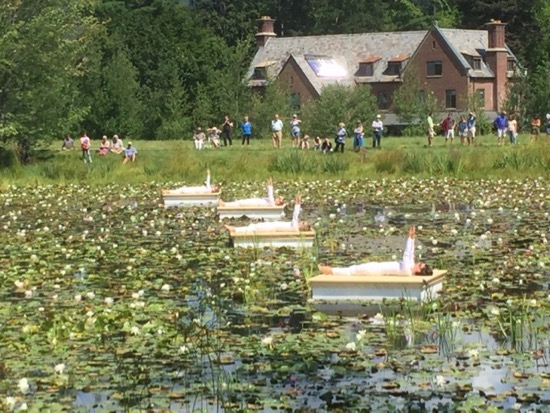
Trisha Brown dancers Cecily Campbell, Leah Ives, Amanda Kmett’Pendry, and Jamie Scott performing Raft Piece.
That Trisha Brown! As wily of mind as she was of body. Her 1973 Raft Piece entails four performers executing her earlier lying-down Group Accumulation on floating, anchored platforms. At the Clark, the resulting image linked two centuries: four women in white outfits and wearing sun glasses built Brown’s ingenious patterns on a pond that Claude Monet might have painted back when water lilies fascinated him. Frogs croaked their support while Campbell, Ives, Kmett’Pendry, and Scott perfectly synchronized their moves—twisting, rolling to one side, turning their heads, swinging an arm or a leg or both, while the platforms occasionally rocked very slightly. These contemporary water nymphs sat up to acknowledge our applause, then had to wait for helpers to row out and liberate them.
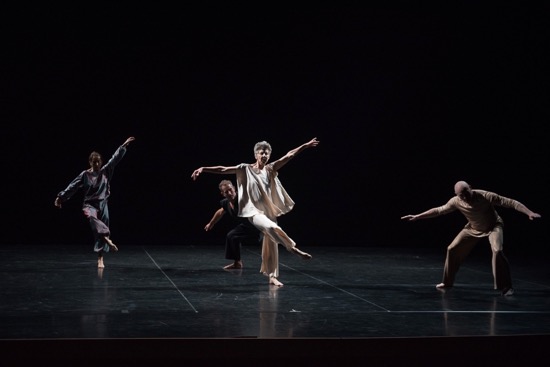
Trisha Brown’s Opal Loop. (L to R): Shelley Senter, Lance Gries, Eva Karczag, and Keith Thompson. Photo: Christopher Duggan
The following Wednesday, the Trisha Brown Dance Company began its six-performance run at Jacob’s Pillow. One of the three works on the program dates from 1980. Back then, it was titled Opal Loop / Cloud Installation #72503. Unfortunately, the Ted Shawn Theater couldn’t properly accommodate the décor referred to in the original title: At its premiere in a New York City loft slightly below Crosby Street, or more recently at the Baryshnikov Center, Fujika Nakaya’s system of powerful sprinklers, lit by Beverly Emmons, created clouds and fog banks into which the dancers could all but disappear. (The piece marked Brown’s second use of “scenery,” as well as introducing the company’s first male dancer: Stephen Petronio.)
The Jacob’s Pillow stage on which Brown company alumni perform Opal Loop is a simpler site. Lance Gries, Keith Thompson, Shelley Senter, and Eva Karczag (who danced in the work’s premiere), are all costumed differently (Judith Shea designed the outfits). To make the dance, Brown combined a phrase of her own making with a filmed improvisation by Steve Paxton (who’d been her colleague in Judson Dance Theater in the 1960s and in the collaborative Grand Union during the 1970s).
I can’t tell you what fine games she played with that material, but what you see are four adept, fluent, mature dancers finding places and ways in which to share or copy one another’s steps. The movement itself is light-footed and sinuous, so it seems almost coincidental that two people suddenly slip into unison and just as suddenly drift apart. You begin to recognize certain maneuvers when they appear on one person’s body and then seem to be transferred to someone else’s. It’s like a party in which meaty hors d’oeuvres keep being passed around; you grab one you like the look of from a platter nearing you and then join some friends surrounding another appetizing array, stick with that a while, and wander off.
Brown found strategies to hint at what structural deviltry she was up to, and as Emmons’ lighting dims slightly, Gries and Karczag begin to hold each other in various ways, while—aligned with them at either end of a diagonal—Thompson copies one of them, Senter the other. One embraces an invisible partner; down the line, the other is embraced.
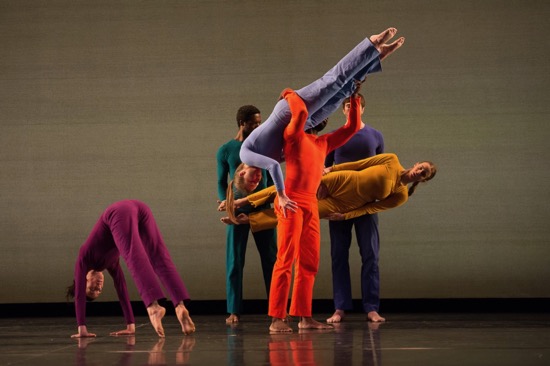
Trisha Brown’s Groove and Countermove. (L) Cecily Campbell; (at back) Kyle Marshall (L) and Patrick McGrath hold Amanda Kmett’Pendry; (foreground) Oluwadamilare Ayorinde lifts Kimberly Fulmer. Photo: Christopher Duggan
Groove and Countermove is the third dance in Brown’s El Trilogy (2000-2001). It’s set to music for trumpet, bass, accordion, violin, and percussion by innovative jazz trumpeter and composer Dave Douglas. When she was preparing the first dance of the three, Brown studied Mura Dehn’s footage of dancing at Harlem’s Savoy Club in the 1930s, and you see none of what’s called “jazz dance” today. Occasionally the dancers’ hips swing; occasionally they’re fast on their feet or lazy with their shoulders. But, like the music, they’re often sporadic, often quiet. Any one or several of them may leave the stage for a while and then return.
I’m not sure the extent to which Elizabeth Cannon’s costumes “reimagine” the originals by Terry Winters, but these nine gifted dancers are clad in vibrantly colored untitards. When they stand or lie in a line stretching from the audience to the back of the stage, they resemble a subversive rainbow. Down that line, they pass gestures in a rippling wave or shift interior moves to create diversity within order.
Sometimes, as in the music, a soloist separates from the ensemble. And we begin to know the dancers as idiosyncratic streaks of color: Ayorinde in bright red, Kmett’Pendry in yellow, Campbell in fuschia, Kimberly Fulmer in blue-gray, and so on with Ives, Patrick McGrath, Kyle Marshall, Leah Morrison, and Jacob Storer. They’re as vivid as tropical birds, and when they congregate in two marvelous trios or form complex physical structures and transfers of agency without arresting flow, you’d better keep your eyes sharp.
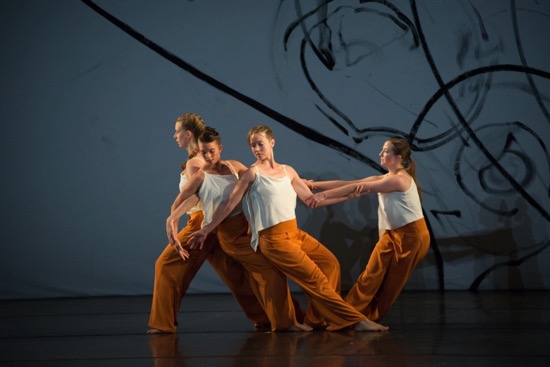
(L to R): Amanda Kmett’Pendry, Cecily Campbell, Leah Ives, and Kimberly Fulmer in Trisha Brown’s L’Amour au théâtre. Photo: Brooke Trisolini
Brown choreographed the delicious L’Amour au théâtre in 2009. By then, she was collaborating with famous dead composers, in this case Jean-Philippe Rameau (1683-1764), drawing arias and instrumental passages from his Hippolyte et Aricie (as recorded for Erato by William Christie and Les Arts Florissants). Back in 1733, that opera was radical enough to be fought over. Brown, of course, wasn’t interested in its mythological tale of incestuous lust, but in the visions it provoked and its multitude of gavottes and other 18th-century dance forms (I thought I heard a hornpipe and glimpsed a jaunty corresponding step).
In this work, the four women (all those named but Morrison) are dressed alike by Elizabeth Cannon in full, dark orange pants and flowing white sleevless tops. The four men wear white pants and chest-hugging gray shirts. Taken together, these superlative performers don’t function as happy stand-ins for the original singers and dancers, but embody the tangles of the plot and the musical imagery conjured up by the music. A lively song in the opera, preceded by an instrumental passage, urges everyone to join a hunt (“A la chasse!”), and at one point in the piece, dancers gallop along in a closely knit group, rocking as they go. You can envision a ship breasting the waves, but also a horse-drawn carriage racing to some event. At another point, the men pair up, so that each couple can support a woman; seated high, the two “ladies” acknowledge each other. They’re earthy compared with the backdrop. One of Brown’s black-and-white sketches blown up, it races along in thick, straight lines, slim curves and delicate marooned snarls. It could be a code I won’t try to crack.
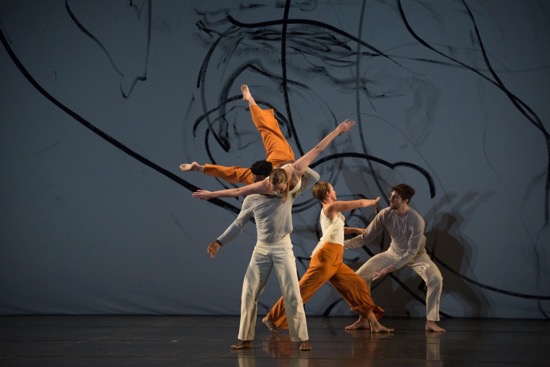
L’Amour au théâtre. (L to R): Oluwadamilare Ayorinde lifting Amanda Kmett’Pendry, Leah Ives, and Patrick McGrath. Photo: Brooke Trisolini
The choreography is full of the low, springy, unaccented jumps that are part of the style Brown developed. The dancers are nimble—virtuosic—yet easy in their skins. They can set a current of movement trickling or gushing through their bodies, causing a shoulder to roll, a knee to lift, an arm to swing, a head to turn—maybe all at the same time. And no matter how tricky the flying lifts and complex patterns, they’re not performed with knock-‘em-dead assertiveness. I once thought that no one could move like Trisha Brown. And then she taught—inspired—others to develop a like fertility of mind and body.
In the latter part of her career, she also developed an idiosyncratically theatrical sense of timing and spatial design, so that you felt yourself drawn along a variegated terrain. Looking back on the path from her early works to her later ones, I understand that while she was developing her art, she was also teaching us how to see it.

Perhaps, too, Brown was traveling, in memory, along the “variegated terrain” of her childhood in Aberdeen, Washington, where she played in the lapping waters of Puget Sound and climbed the tall trees of the forest that was only a little further inland. I too think of this seriously and unpretentiously intellectual artist as playful, relaxed, free, unconstrained, unfettered by convention, and I grieve for the loss of her. Thank you Deborah for bringing her back with such unforced eloquence and I thank the dancers as well.